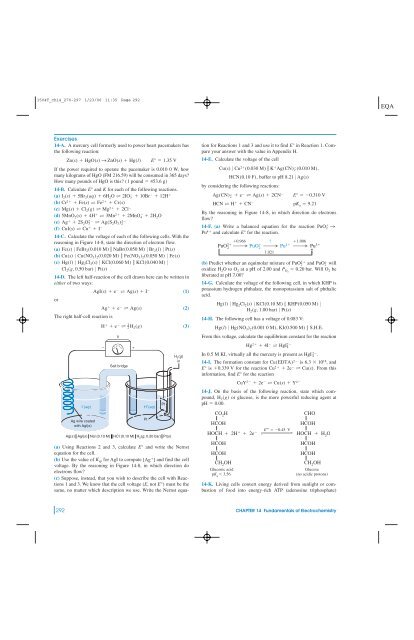Fundamentals of Electrochemistry - W.H. Freeman
Fundamentals of Electrochemistry - W.H. Freeman
Fundamentals of Electrochemistry - W.H. Freeman
You also want an ePaper? Increase the reach of your titles
YUMPU automatically turns print PDFs into web optimized ePapers that Google loves.
1504T_ch14_270-297 1/23/06 11:35 Page 292<br />
Exercises<br />
14-A. A mercury cell formerly used to power heart pacemakers has<br />
the following reaction:<br />
Zn(s) HgO(s) S ZnO(s) Hg(l)<br />
If the power required to operate the pacemaker is 0.010 0 W, how<br />
many kilograms <strong>of</strong> HgO (FM 216.59) will be consumed in 365 days?<br />
How many pounds <strong>of</strong> HgO is this? (1 pound 453.6 g)<br />
14-B. Calculate E° and K for each <strong>of</strong> the following reactions.<br />
(a) I 2 (s) 5Br 2 (aq) 6H 2 O T 2IO 3 10Br 12H <br />
(b) Cr 2 Fe(s) T Fe 2 Cr(s)<br />
(c) Mg(s) Cl 2 (g) T Mg 2 2Cl <br />
(d) 5MnO 2 (s) 4H T 3Mn 2 2MnO 4 2H 2 O<br />
(e) Ag 2S 2 O 2 3<br />
T Ag(S 2 O 3 ) 3 2<br />
(f) CuI(s) T Cu I <br />
14-C. Calculate the voltage <strong>of</strong> each <strong>of</strong> the following cells. With the<br />
reasoning in Figure 14-8, state the direction <strong>of</strong> electron flow.<br />
(a) Fe(s) 0 FeBr 2 (0.010 M) NaBr(0.050 M) 0 Br 2 (l) 0 Pt(s)<br />
(b) Cu(s) 0 Cu(NO 3 ) 2 (0.020 M) Fe(NO 3 ) 2 (0.050 M) 0 Fe(s)<br />
(c) Hg(l) 0 Hg 2 Cl 2 (s) 0 KCl(0.060 M) KCl(0.040 M) 0<br />
Cl 2 (g, 0.50 bar) 0 Pt(s)<br />
14-D. The left half-reaction <strong>of</strong> the cell drawn here can be written in<br />
either <strong>of</strong> two ways:<br />
AgI(s) e T Ag(s) I <br />
(1)<br />
or<br />
Ag e T Ag(s)<br />
(2)<br />
The right half-cell reaction is<br />
H e T 1 2 H 2(g)<br />
(3)<br />
I − (aq)<br />
Ag wire coated<br />
with Agl(s)<br />
V<br />
– +<br />
Salt bridge<br />
H + (aq)<br />
Ag(s) Agl(s) Nal (0.10 M) HCI (0.10 M) H 2 (g, 0.20 bar) Pt(s)<br />
(a) Using Reactions 2 and 3, calculate and write the Nernst<br />
equation for the cell.<br />
(b) Use the value <strong>of</strong> K sp for AgI to compute<br />
E°[Ag ] and find the cell<br />
voltage. By the reasoning in Figure 14-8, in which direction do<br />
electrons flow?<br />
(c) Suppose, instead, that you wish to describe the cell with Reactions<br />
1 and 3. We know that the cell voltage (E, not E°) must be the<br />
same, no matter which description we use. Write the Nernst equa-<br />
Pt<br />
E° 1.35 V<br />
Pt<br />
H 2 (g)<br />
in<br />
tion for Reactions 1 and 3 and use it to find E° in Reaction 1. Compare<br />
your answer with the value in Appendix H.<br />
14-E. Calculate the voltage <strong>of</strong> the cell<br />
Cu(s) 0 Cu 2 (0.030 M) K Ag(CN) 2 (0.010 M),<br />
HCN(0.10 F), buffer to pH 8.21 0 Ag(s)<br />
by considering the following reactions:<br />
Ag(CN) 2<br />
By the reasoning in Figure 14-8, in which direction do electrons<br />
flow?<br />
14-F. (a) Write a balanced equation for the reaction PuO2 S<br />
Pu 4 and calculate E° for the reaction.<br />
0.966 ?<br />
1.006<br />
PuO2<br />
2<br />
PuO<br />
¡ 2 ¡ Pu 4 ¡ Pu 3<br />
1.021<br />
c<br />
(b) Predict whether an equimolar mixture <strong>of</strong> PuO 2 2 and PuO 2 will<br />
oxidize H 2 O to O 2 at a pH <strong>of</strong> 2.00 and P O2<br />
0.20 bar. Will O 2 be<br />
liberated at pH 7.00?<br />
14-G. Calculate the voltage <strong>of</strong> the following cell, in which KHP is<br />
potassium hydrogen phthalate, the monopotassium salt <strong>of</strong> phthalic<br />
acid.<br />
Hg(l) 0 Hg 2 Cl 2 (s) 0 KCl(0.10 M) 7 KHP(0.050 M) 0<br />
H 2 (g, 1.00 bar) 0 Pt(s)<br />
14-H. The following cell has a voltage <strong>of</strong> 0.083 V:<br />
Hg(l) 0 Hg(NO 3 ) 2 (0.001 0 M), KI(0.500 M) 7 S.H.E.<br />
From this voltage, calculate the equilibrium constant for the reaction<br />
In 0.5 M KI, virtually all the mercury is present as HgI 2 4 .<br />
14-I. The formation constant for Cu(EDTA) 2 is 6.3 10 18 , and<br />
E° is 0.339 V for the reaction Cu 2 2e T Cu(s). From this<br />
information, find E° for the reaction<br />
14-J. On the basis <strong>of</strong> the following reaction, state which compound,<br />
H 2 (g) or glucose, is the more powerful reducing agent at<br />
pH 0.00.<br />
CO 2<br />
H<br />
HCOH<br />
HOCH 2H 2e <br />
HCOH<br />
HCOH<br />
CH 2<br />
OH<br />
Gluconic acid<br />
pK a<br />
3.56<br />
e T Ag(s) 2CN E° 0.310 V<br />
HCN T H CN pK a 9.21<br />
Hg 2 4I T HgI 2 4<br />
CuY 2 2e T Cu(s) Y 4<br />
E¿ 0.45 V<br />
CHO<br />
HCOH<br />
HOCH<br />
HCOH<br />
H 2<br />
O<br />
HCOH<br />
CH 2<br />
OH<br />
Glucose<br />
(no acidic protons)<br />
14-K. Living cells convert energy derived from sunlight or combustion<br />
<strong>of</strong> food into energy-rich ATP (adenosine triphosphate)<br />
292 CHAPTER 14 <strong>Fundamentals</strong> <strong>of</strong> <strong>Electrochemistry</strong>

















